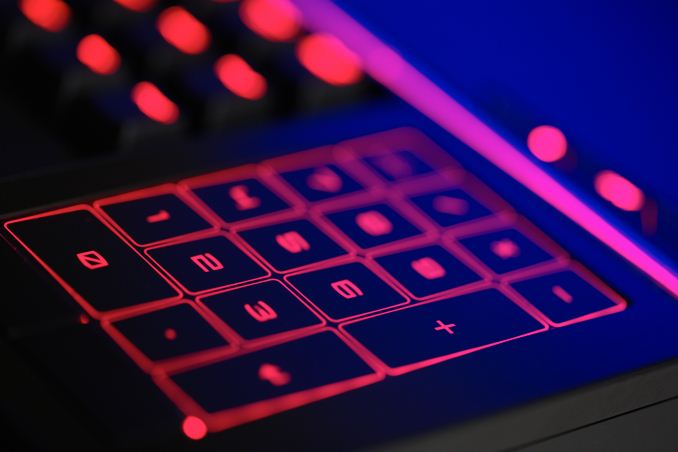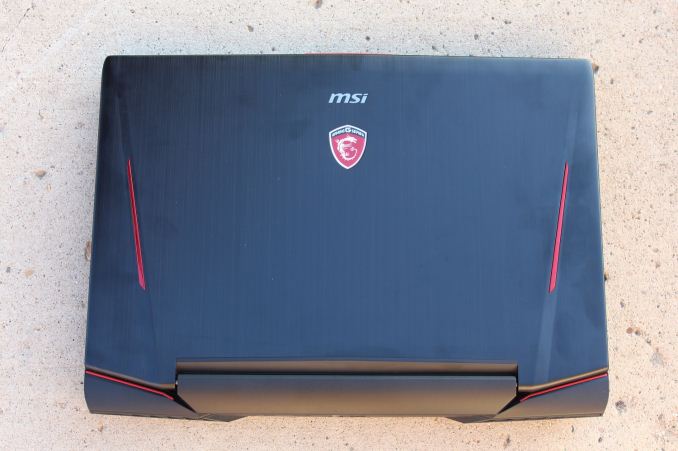The MSI GT80 Titan Review: The Broadwell Gaming Laptop Your Desktop Envies
by Brett Howse on June 26, 2015 8:00 AM ESTFinal Words
When I first saw the GT80 I was intrigued that they managed to stick a mechanical keyboard onto a gaming laptop, but I thought it was a bit large and unwieldy. But when I go into a review I try to set those preconceptions at the door. Am I ever glad I did. MSI has designed a pretty amazing piece of kit here, which is well built, nice to use, and buckle up fast.
It really all starts with the keyboard, which is obviously the focal point. No one else has yet managed to squeeze a mechanical keyboard with Cherry MX switches into a laptop, and the end result is something so unique, but yet so nice to use. Perhaps I am old school but I have always preferred using a desktop computer over anything, and the GT80 Titan with its desktop keyboard smack on the front just works so well.
The trackpad is almost an afterthought but by combining it with the number pad, it is at least in a spot where it is easy to use, and not over top of the keyboard which would make it very awkward. The vertical rotation of it takes a bit of getting used to, but it does work pretty well. Unfortunately it is less useful as a number pad because it is touch based, but it is there when needed. The GT80 Titan is pretty much designed to be used with a mouse though, so the trackpad is really just there when you need it.
The display is massive at 18.4-inches, and as our results show it is a nice accurate display when set to sRGB mode. I appreciate the effort MSI put in to the device to offer an accurate mode as well as some other modes which can be easily switched to depending on the application. The pedestrian resolution is a bit of a letdown, mostly because the Titan is fast enough that it could game at a higher resolution than 1080p pretty easily. The lack of G-SYNC is also disappointing since MSI does offer it on the GT72 now. Most of the time though you are never really near the refresh rate anyway, but since this is one of the most expensive gaming laptops around, it really should be offered with G-SYNC.
Broadwell has been slow to arrive in its quad-core form, but I have to say I am impressed. Intel only says it is a couple percentage points quicker than Haswell in IPC, but the new processes opens up the processor to be able to maintain its Turbo frequencies longer, and it ends up outperforming Haswell parts that are up to 500 MHz faster in our benchmarks. It’s almost too bad Broadwell will be so short lived, but we shall see what the rollout of Skylake is.
The GTX 980M is undoubtedly the fastest mobile graphics card around, and once you add a second one in SLI you are talking about some serious compute power. This is first and foremost a gaming laptop, and it is heads and tails faster at gaming than any laptop we have ever seen. It’s not even close. It is also great to see MSI offering upgradability on this laptop both now, and in the future, by leveraging MXM graphics cards which can be swapped out at a later date if the GTX 980Ms start to show their age. And that’s doubly good because the people purchasing the GT80 Titan are really making a big investment.
Pricing is pretty steep on the GT80 Titan. I can buy a good Ultrabook for $1000-$1500. The GT80 Titan starts at $2500, and can go all the way up to $3800. The one we received would be at the higher end of that range at around $3400. It’s a big investment, and for that money you get not only the laptop, but some nice perks too like a backpack to carry it in (which is good because it’s so big most backpacks won’t be able to) as well as a mousepad, palm rest, keychain, and some gold key caps you can switch into the keyboard. You of course also get one of the fastest laptops around, and the only one around with a mechanical keyboard. If you are OK with a laptop that really is meant as a desktop replacement, you would be doing yourself a disservice by not checking out the GT80 Titan.













103 Comments
View All Comments
EzioAs - Friday, June 26, 2015 - link
I'm surprised to see the temperature and cooling of this notebook. I thought all gaming notebooks with high-end GPUs had inadequate cooling, thus leads to high temps. Clearly, I'm wrong here.Nice tongue twister on the intro btw.
Refuge - Friday, June 26, 2015 - link
I would hope with how much extra room they have over other things like the P35x that there wouldn't be heat issues.der - Friday, June 26, 2015 - link
20th comment!extide - Friday, June 26, 2015 - link
Nah most high end gaming laptops like this, alienware, or clevos have pretty good cooling. Essentially you want a dedicated fan for the CPU and another one for the GPU (or two, in this case, for the two gpu's)extide - Friday, June 26, 2015 - link
Although, this one cools the CPU with the 2 GPU fans, which should be fine, it's generally the GPU that you need to worry about overheating anyways.WinterCharm - Friday, June 26, 2015 - link
More important than dedicated fans is the actual layout and capacity of the heat pipes and heat sinks.Also some of the cheaper/worst designs are ones that put the CPU and GPU on the same heat pipes, as this often leads to throttling when both components are running at full bore.
extide - Friday, June 26, 2015 - link
Yeah, but those are ones where the cpu and gpu share a single small fan, this one shares the cpu across both gpu fans, which are suitably large.nerd1 - Saturday, July 4, 2015 - link
Very few applications taxes both CPU and GPU hard so shared heat pipes actually makes sense.Notmyusualid - Friday, June 26, 2015 - link
As an owner of an M18x R2 (i7 Extreme), and a few other notebooks, I can say that the shared-cooling solution is much better.Some games are more GPU-heavy, some CPU-heavy, and that goes for other workloads too. Sharing the cooling across multiple devices may help you achieve better performance in the long run.
Out of interest, I will, at some point link up all three fans in my Alienware when time allows, but only when my warranty expires.
WinterCharm - Friday, June 26, 2015 - link
A lot of better designed notebooks do not have cooling issues. Of course you pay a premium for them, but you get what you pay for in this case.